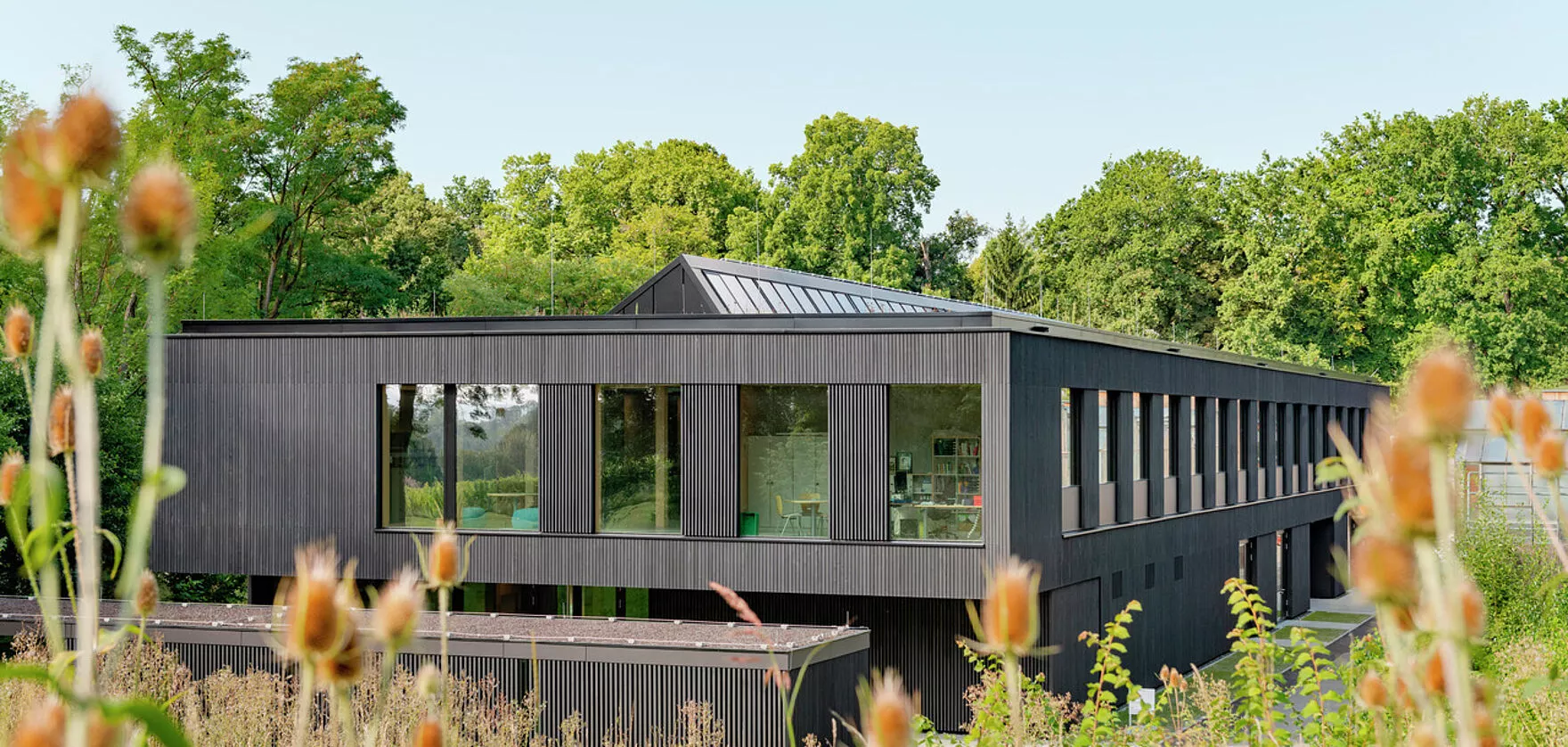Grand Hotel Łódż
The Grand Hotel in Łódź, a vibrant university and industrial city in Poland, has been the epitome of…

If you build for nature, you inevitably build naturally. With this in mind, the State Institute for Apiculture was constructed as a sustainable building using a timber hybrid construction method. The façade is allowed to age by itself over the years. To ensure that it remains beautiful in the meantime, it was pre-greyed.
Bees, honey and honeycombs: These topics are the focus of the State Institute of Apiculture, a unique institution of a university in Germany. The diversity of research approaches conducted at this location ranges from molecular genetics to experimental field research -optimal conditions for the team of experts dedicated exclusively to bee science.
For many years, the researchers had conducted their studies in an old building from the 1960s. Now Lanz Schwager Architekten BDA have designed a new building on behalf of the Stuttgart and Hohenheim University Building Authority that has been explicitly adapted to the requirements of the bee experts. Against this background, the building, which is set in the middle of nature on the edge of the university campus, takes on several tasks: It serves as a laboratory building where research is conducted on various bee topics and as a training building where beekeepers can learn more about the beneficial insects in special seminar rooms. At the same time, it functions as a university building where students can attend courses. It contains a research apiary with a carpentry workshop, wax and extracting room, where honey is produced and bee boxes are built. In the south of the complex, there is also space for offices for the institute.
For reasons of sustainability, the building was constructed entirely in timber hybrid construction. This was a requirement of the Landesbetrieb Vermögen und Bau (State Office for Property and Construction) in order to use this building as a pilot project for sustainable construction with BNB certification as an example for advancing timber construction in Baden-Württemberg. In order to ensure the required fire and noise protection as well as the static requirements of the structure, recycled concrete was also used in the core zone of the building, including the two staircases.
“The type of wood chosen for the facades also plays a significant role in the ecological quality of the building,” says Stephan Seidel, Managing Director of häussermann GmbH & Co. KG, which was entrusted with the planing and coating of the facade mouldings for the project. “Silver fir grows predominantly in southern Germany as well as in Austria, so it is native in contrast to the Siberian larch. Moreover, the wood of the silver fir is resin-free, light-coloured and has an exceptionally good quality,” Seidel continues. With a special cutting process – rift/half-rift – boards specially suited for facade construction can be produced from the raw material.
Over the years, the wood greys just as beautifully and naturally as the imported larch wood. With both types of wood, however, the same danger threatens until the final colour change: “During the transition period, the wood greys differently, on the weather side and in places exposed to the weather faster than in protected areas,” informs Seidel. “To ensure that the wood remains beautiful during the transitional period, we have therefore treated it twice with the silicate greying stain KEIM Lignosil-Verano, shade 4895.” This allows the surfaces to age evenly and compensates for deviations – for example, at projections or recesses. A wooden facade pre-treated in this way also requires no further maintenance after the double treatment. Compared to conventional pre-greying, weathering is also slower because the binder is mineral and is not destroyed by UV radiation. Only wind and rain contribute to weathering. Since the chosen glaze does not contain any biocides, preservatives or solvents, it is also harmless to insects. Last but not least, the diffusion-open and non-film-forming KEIM Lignosil-Verano is non-combustible and contributes to faster drying of the wood due to its mineral surface structure. The product has been awarded Cradle to Cradle Certified® Silver and C2C Certified Material Health Certificate™ Gold.
The contrast between the light wooden surfaces of the interior and the dark outer skin was expressly desired by the architects as well as the client. “In addition, we wanted everything to look as natural and untreated as possible,” Voswinckel notes. Accordingly, the exposed concrete of the building’s core was only treated with a colourless, matt glaze from Keim (Concretal) to give it a calmer appearance and reduce it to its original quality.
In the foyer of the new building, a wall relief carved out of wood called “Die Scharfgabe im Paradies” by Gabriela Oberkofler symbolically points to the importance of nature and the topic of sustainability. The fact that this goal was also implemented in reality is embodied in the entire new building of the State Institute for Apiculture. The new building was certified according to the specifications of the Sustainable Building Rating System for Federal Buildings (BNB).
The Grand Hotel in Łódź, a vibrant university and industrial city in Poland, has been the epitome of…
A special residential building has been created in a backyard in the heart of Berlin: barrier-free a…
Four modern, family-friendly apartment buildings with 149 flats and an underground car park stand on…
